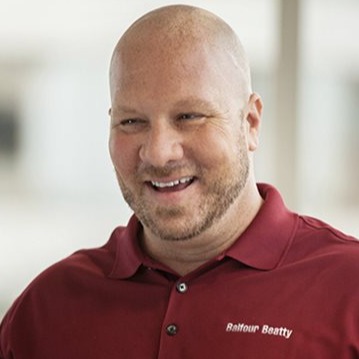Ryan Little

Relentless Ally
Make Every Moment Count
Safety, Health and Environment Director Ryan Little recalls a life-changing conversation that forever impacted his approach to Zero Harm
Do you remember where you were around noon on Saturday April 28, 2007? Were you eating lunch, playing golf or maybe enjoying an afternoon in the park with your children? That day may be a distant memory for most, but fourteen years later, I can still recall every detail because it fundamentally changed me as a safety professional. It changed me as a person. And it reinforced my view of our responsibility to ensure safety is within everyone’s reach – on every task, every day, on every jobsite.
At the time, I was working for another major general contractor on a high-rise project in Miami, Florida. Before I joined the team, the project had already gone wrong in almost every way a project can. Significant and ongoing staffing turnover led to poor management, catastrophic schedule delays and communication breakdowns such as the mass overstocking of drywall. With a booming local economy, second-tier trades were pressed to meet aggressive production targets on advanced scopes. We even dismantled the first tower crane as a hurricane was approaching. This project had nearly every risk factor for a serious safety incident.
But we never expected that on April 28, someone would lose their life on our jobsite. A 26-year-old young man from Nicaragua fell 90 feet to his death while moving some of the building’s extra drywall onto an outrigger. This tragedy was entirely preventable—the result of a series of unsafe choices, an acceptance of unnecessary risk and a toxic ‘rip and react’ project culture that failed to address either dangerous dynamic.
But before I explain the technical circumstances that led to this young man’s death, I’d like to set the stage for the challenges our workforce faces and why I immediately recognized that I could have done more to ensure safety was within his reach.
This young man was being paid $.25 cents for each board of 70-pound drywall he moved. It was physically demanding, repetitive and production-driven work. Every night, he went home to a one-room extended stay motel that he shared with six brothers and sisters.
When I was notified about the fatality, I remembered riding up an elevator with that young man earlier the same day. As I went through a roller coaster of emotions, I replayed every moment of the interaction in my mind. After a quick PPE check, I asked him to put on his eye protection in my best Spanish. With a smile and a nod, he did just as I’d asked. But I didn’t check for his orientation sticker or verify what task he was working on. I didn’t engage him in a personal conversation. By not maximizing that moment, I felt I had failed him.
When I spoke to his mother just a few hours later, that missed opportunity flashed before my eyes. She asked me a haunting question no parent should ever have to ask and no safety professional ever wants to answer: “Why did you let my son die on your jobsite?”
I could have told her that the outrigger subcontractor had gone to lunch, leaving the system unmonitored. I could have told her that his crew grabbed some unattended harnesses they hadn’t been trained to use and loaded boards onto an outrigger they weren’t authorized to work on. Or that they’d removed their retractables, so when the load on the outrigger shifted, they had no adequate fall restraint measures in place. But none of those responses would have brought her any comfort, and none would have brought her son back. They didn’t bring me any comfort either.
We owe the people who work on our projects more than leaving their lives to luck or chance, but far too often in this industry, we believe we are safe when we just got lucky. Or, we assume that people will make safe choices because we think they seem like common sense. But that’s not always the case. Yes, these young men made misguided and unsafe choices, but their only motive was to get a job done to provide for their families. No one sets out on any given workday with the intent of getting hurt.
This tragedy reminded me that safety isn’t about a sign or a rule. Rules are important and help save countless lives on jobsites every day, but those measures don’t work in isolation.
Safety must be an authentic value we live and operate by every single day. To make safety within everyone’s reach, we must engage in personal conversations with our trade partners and take the time to examine our work through the eyes of the people performing it. By forming meaningful, authentic relationships, we can empower people to make safety, quality and production so deeply ingrained into their everyday operations that it’s as routine as putting on a seatbelt. They also need to understand it’s their right and responsibility to speak up if they see something unsafe.
At its core, safety is rooted in trust—trust our workforce places in us to create safe jobsites, trust they place in one another to make safe choices and trust that everyone operates with one another’s best interests at heart.
In the wake of any safety incident, there are always difficult questions to answer. Some questions, like the one the young man’s mother posed to me, can’t be answered because there are no do-overs. To honor his memory, challenge yourself today to honestly evaluate whether you embody the leadership, courage and commitment to make safety within everyone’s reach on your team, jobsite or office environment.
Don’t let a single ‘elevator moment’ pass you by.